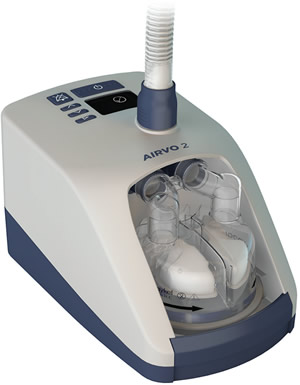Product Profile
Airvo: Bringing a New Therapy Home
Nasal high-flow therapy is a relatively new method for helping patients clear dry, clogged airways, and the Airvo is introducing it to the home setting.
- By David Kopf
- Dec 01, 2018

The Airvo aims to help a wide variety of patients that have issues with secretion mobilization. They need help clearing their upper respiratory system. The device delivers warm, humid air at continuous pressure to liquefy debris in the upper airway and help patients cough that material out. The therapy debuted in the hospital setting, but now new products such as Airvo are bringing the therapy into the home setting.
As the respiratory care field learns more about its patients and their conditions, it’s discovering that there is a wide variety of patients having issues with secretion mobilization. Essentially, many patients need help clearing their upper respiratory system so that they can achieve better alveolar ventilation.
Enter nasal high-flow therapy, which delivers warm, humid air at a set flow to liquefy debris in the upper airway and help patients cough that material out or swallow. The therapy debuted in the hospital setting, but now the Airvo from Fisher & Paykel Healthcare is bringing that therapy into the home setting.
What Is Nasal High-Flow?
Essentially, the Airvo combines humidity with high-flow up to 60 L/min. Humidity wise, there are a few temperature settings (in Centigrade) that it provides: 31 degrees, 34 degrees, 37 degrees. With the humidity and high-flow, the device can ensure that the patient is getting proper secretion mobilization.
“Clinical studies have shown that when 100 percent relative humidity (at 37 degrees) is achieved, that secretion mobilization and mucociliary transport system is most effective at getting the debris and some of the things that can cause infections and issues with secretion clearance, it’s the ideal scenario,” says James Gibbons, Airvo product manager for Fisher & Paykel. “What this aims to do is to provide that ideal humidity in liquefying that upper airway.
Small enough that it can sit bedside or used with a mobile pole, the Airvo administers the high-flow via either a nasal cannula or a tracheostomy interface, depending on the patient’s situation. Heated tubing reduces the opportunity for condensation to build up, which helps ensure consistent therapy.
Also, patients can use supplemental oxygen with this device. The oxygen concentrator would be connected to the Airvo via an adapter on the side of the unit. The Air would flow into the Airvo, through the filter, pick up the oxygen and humidification, and then it would deliver the temperature and the flow based on the prescribed settings.
The Market for Nasal High-Flow
So which patient groups need nasal high-flow? That’s a tough question for Gibbons to answer, because the list keeps getting longer as the therapy is applied. There are applications for COPD patients, pediatric patients, mobility patients, and others.
“We’re learning, every single day, different ways that this therapy can be applied,” Gibbons says. “Really, the patient that we’re targeting is one that is having spontaneous breathing issues, issues with secretion mobilization within their mucociliary transport system.
“… When we talk to the pulmonologists, a lot of their light bulbs will go off, because they’re thinking of specific patients, and they don’t necessarily fit the same mold,” he says. “So to that point, the pulmonologist is going to be the main referral source for the HME business, as far as how they’re going to get patients on this product.”
In terms of how long or frequently a patient will use the Airvo, that depends on the patient’s disease state and therapy needs.
“A lot of the clinical studies around humidified high flow have shown that the longer the patient uses it, the better the outcomes are,” Gibbons explains. “To that point, in some of the studies, humidified high flow is used one to two hours a day, in others it’s used six to seven hours a day. When I say day, that doesn’t necessarily mean during the day, it could be at night.”
To ensure providers’ on-staff RTs thoroughly understand the device, Gibbons says F&P recommends they get trained by the company on the device because it is a different therapy with which they’re going to be as familiar.
To help educate referrals on this relatively new therapy and its even new application in the homecare space, Fisher & Paykel has reps in almost every U.S. state to handle in-services, and the company also provides marketing, support and education materials.
“That way [providers] can feel comfortable regardless of whether it’s the physicians at the hospital or the HME providers outside,” he says. “… They can feel comfortable educating the patients on it and providing it for the patients in the home.”
Airvo
Fisher & Paykel Healthcare
www.fphcare.com
(877) 707-5454
This article originally appeared in the Nov/Dec 2018 issue of HME Business.
About the Author
David Kopf is the Publisher HME Business, DME Pharmacy and Mobility Management magazines. He was Executive Editor of HME Business and DME Pharmacy from 2008 to 2023. Follow him on LinkedIn at linkedin.com/in/dkopf/ and on Twitter at @postacutenews.